How to Learn Stock Market Trading

We bet you have already seen a movie about Wall Street. In almost every movie, there are scenes where people in suits are yelling “BUY!” and “SELL!” and lots of different numbers are flashing on big screens everywhere. Is that actually what stock market trading is all about?
Not quite; it is a part of the stock market, but it’s just a very small part of it. In reality, it is less spectacular but for sure still as interesting. Let’s unwrap.
Stock market trading, put simply, is the buying and selling of company shares. Imagine owning a teeny, tiny piece of Apple or Amazon. Neat, right? You're not just buying bragging rights, though. Those pieces, or “stocks,” represent a slice of the company's value. When the company does well, your slice's value might increase. When it doesn’t… well, let’s say your slice might resemble a raisin more than a full-blown pie.
Why Should You Care?
The main reason why you should care is because trading the stock market can grow your wealth.
“Overall capitalism [meaning free markets] is intrinsic to the human species. Capitalism is not something we invented. Capitalism is not even something we discovered. It is in us in every exchange that we have.”
Naval Ravikant
Investing in the stock market is often portrayed as gambling. Sure, many parts resemble gambling, and many foolish investors behave like they are in a casino, betting left and right.
For serious investors, it is the complete opposite. If you approach it the right way, it can be a great way to grow your wealth and it is not like gambling at all. In fact, the longer you invest and hold, the higher your odds of making money. The chart below shows that if you’re invested for 15 years, your odds are 99.8% to be in the green! No casino can offer you that!

Brief Overview of the Stock Market
The stock market is similar to a marketplace, but we buy and sell companies instead of fruits and vegetables. At its core, the main goal is to allocate capital. You basically give your money to the best CEOs because you hope they will make the best use of it. When you invest, you're essentially funding the building blocks of our society – businesses, corporations, and innovative projects. If those at the helm of these ventures make wise use of your funds, both they and you benefit in the long run with capital growth. As the chart below shows, stocks have probably been the best asset to invest in since the 1900s.
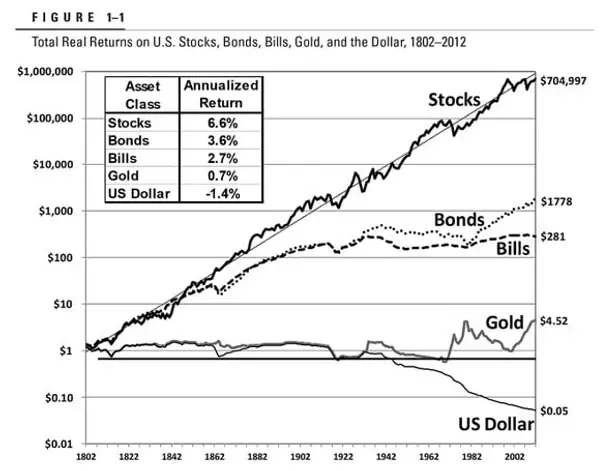
Broadly speaking, that is all that is to it, simple. Buy a piece of a company and hope that it will do good business and grow in value over time.
We hope these facts could already spark your interest, and you can’t wait to ask more questions like: How do I buy a stock? How do I pick a company that will rise in value? How do professionals invest?
We will answer all of these questions and more in this article, so keep reading and learn everything there is about stock market trading:
- Stock Market Trading Basics
- How to Develop a Winning Stock Trading Strategy
- How to Find a Trading Platform That You Can Trust
- Practice and Review Your Trading Performance
Stock Market Trading Basics
How Stocks are Traded
Stocks can be traded in many different ways. Today, it is very simple as you just need to download an app, deposit some money, and simply click on a stock you want to invest in. Back in the day, people had brokers who bought the stocks you wanted for you. Nevertheless, both go back to the same place, mostly the New York Stock Exchange or NASDAQ.
Companies list their shares on these exchanges, making them available for the public to buy or sell. Investors use brokers, either human or online platforms, to place their trading orders.
That is also the reason why prices change throughout the day, driven by supply (sellers) and demand (buyers). When a buyer's price matches a seller's offer, a trade is executed, and ownership of that stock changes hands. So, in general, the price of a stock is created by supply and demand, the oldest concept for price in the book. But are there more factors that could influence stock prices? Theoretically, no. However, there are a multitude of factors that influence the demand and supply dynamics of stocks. These concepts are crucial for your understanding of stock market trading so we will talk about them next.
Fundamental Concepts
- Supply and Demand:
Think of a popular band coming to town. If there are limited tickets available (low supply) and everyone is eager to attend the concert (high demand), ticket prices will skyrocket. On the other hand, if the band isn't that popular or if there are numerous shows scheduled, leaving a surplus of tickets (high supply) and fewer fans rushing to buy them (low demand), the ticket prices might get slashed. Stocks work the same way.
- Bull and Bear Markets:
Think of these as the moods of the stock market. A bull market is like a big party where stocks are having a good time. A bear market? It's more of a downer; stocks aren't feeling great. Below, there's a chart showing the U.S. stock market's ups and downs (bulls and bears) from 1957 to 2022.
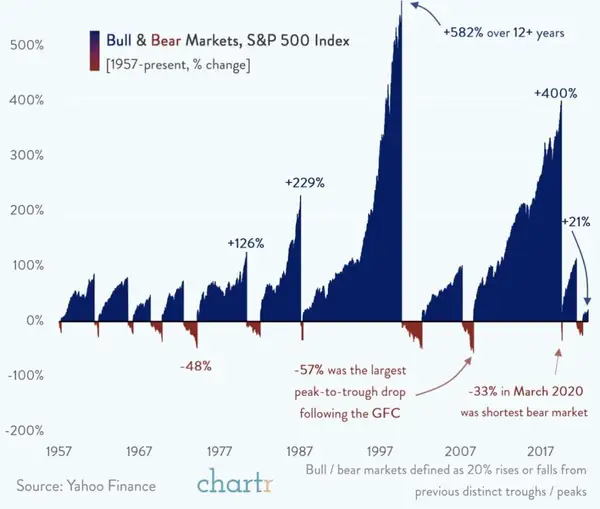
As you can see, bull markets mostly dominate, with short periods of bear markets where the market actually brings negative returns overall.
3. Market Capitalization
Following the bulls and bears, we encounter the concept of “market capitalization,” often referred to as “market cap.” This is a simple yet profound measure of a company's total value in the stock market. Think of it as the price tag of a company if you want to buy the whole thing. It's calculated by multiplying a company's share price by its total number of outstanding shares. So, if a company has a million shares and each is priced at $50, its market cap would be $50 million.
Companies are often categorized based on their market cap: “large-cap” are the market behemoths with values over $10 billion, “mid-cap” lie in the middle ground, typically between $2 billion and $10 billion, and “small-cap” are the more nimble players valued below $2 billion.
The chart below shows you the 5 largest US stocks by market capitalization, with Apple leading the way in 2023.
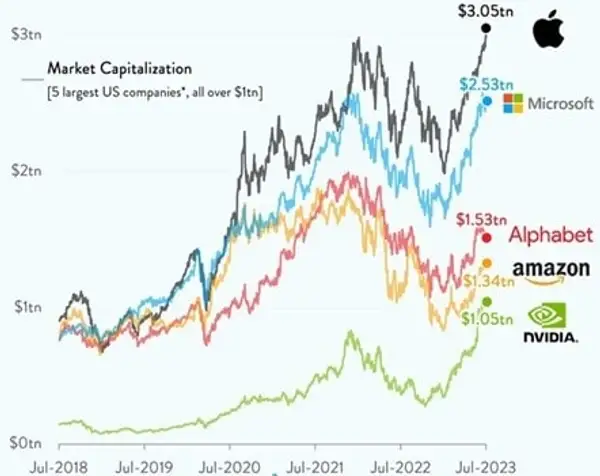
Understanding market capitalization will help you gauge a company's size, risk, and potential growth relative to others in the market. Here is an interesting chart that actually shows how big of a difference market capitalisation can make in times of uncertainty.
4. Passive or active investing
Finally, before starting to invest, the last choice is whether you are an active or passive investor. In general, you're presented with two fundamental approaches: passive and active investing.
Passive investing aims for long-term appreciation and mirrors the performance of a specific market index. A prime example is the S&P500, an index fund representing the 500 largest US companies. Over the last decade, it reported an annual compounded return of 13.2%.
Pros:
- Broad Exposure: You invest in a cross-section of the market, reducing the risk tied to individual companies.
- Low Effort: Once you've invested, there's minimal management required.
- Cost-Effective: Typically has lower fees than active investing due to less frequent trading.
Cons:
- Limited Returns: Your gains are tied to the market; you won't outperform it.
- Less Control: You can't pivot your investment based on individual company performance or specific insights.
For many, the passive investing approach might be the right choice, as the average investor generally does not outperform the overall market.
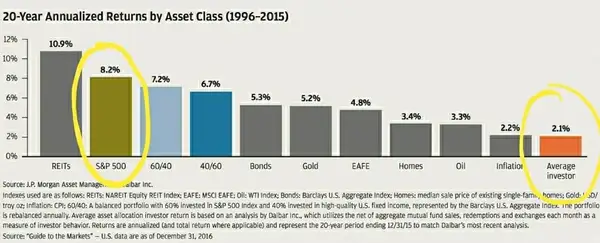
However, while passive investing offers a more hands-off approach anchored to the market's broader movements, active investing requires deeper involvement but holds the promise of potentially higher returns.
Active Investing is about individual stock selections, timing, and strategy. Investors actively decide what to buy or sell, often aiming to beat the market.
Pros:
- Potential Higher Returns: Ability to outperform the market if your bets are right.
- Flexibility: Can adapt quickly to market changes based on research and insights.
Cons:
- Requires More Work: Demands constant market analysis and understanding.
- Higher Costs: Frequent trading can lead to higher fees and tax implications. (Use a platform like Morpher to avoid fees altogether.)
In this article, we will talk more about active trading, as we want to try to maximize our returns.
The chart below will actually show you why we would rather try to focus on picking stocks than just investing in a whole index. For example, in 2023, the overall market, 493 companies of the S&P 500, on average, did not increase at all, whereas the 7 biggest companies by market capitalization increased by +53%. That is a clear win for active trading. Let's now try to understand how to develop a winning strategy to pick the right stocks to trade.
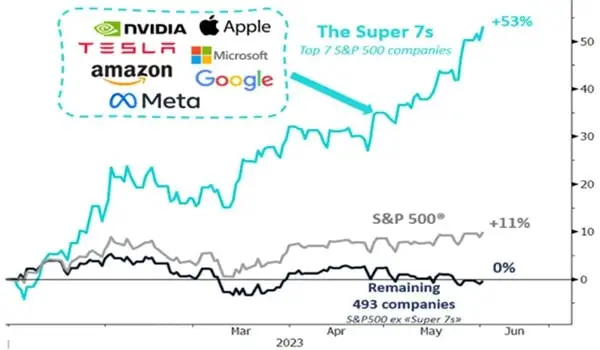
How to Develop a Winning Stock Trading Strategy
Now that we decided to go for a higher potential return, let us look into how to develop a winning stock trading strategy. Obviously, there is no straightforward answer to this question but we will give you the toolkit to create your own strategy.
Setting Financial Goals
First of all, we have to set our financial goals. In general, try to figure out your “Why” first. Why do you want to invest? Is it for a dream vacation, buying a house, or just increasing your wealth? Your ‘why' will guide your investment strategy.
“If a man does not know what port he is steering for, no wind is favorable to him.”
Seneca
1. Short-Term vs. Long-Term Goals
Try to stay as realistic as possible. You will unlikely achieve extremely high returns in the beginning, so calculate your timeframe accordingly.
The types of investments you will make will strongly depend on your time horizon. If you have ambitious short-term goals to reach, you will more likely invest in assets that are more risky. Stocks with high volatility would probably be more fitting for that. If you have long-term goals, you might rather look into value investing, where you do not care if the stock price will go up in the near term, as your horizon is five to ten years or more. Over time, the market has historically trended upwards, which can help mitigate risks associated with market volatility
2. Risk Tolerance
Remember, with high rewards come high risks. It's crucial to ensure you're comfortable with the amount of risk you're taking and understand the potential for loss. Risk tolerance and risk management are definitely a topic to look into, as one of the most cited investors in history pointed out that avoiding losses takes priority over improving gains:
“To make up for a 95% loss in value requires the investor to make an astounding gain of 1900%.”
Benjamin Graham
So even if you have multiple wins in a row and can multiply your portfolio by 100%+, one bad trade can ruin your whole portfolio as you will most likely not be able to recover from a 95% loss.
A monumental example of leverage gone wrong was when 3AC, a crypto hedge fund with 10Billion at peak, lost all its funds due to an overleveraged position in a failed crypto project.
Another notable example is Bill Hwang who lost $20 Billion in two days due to overleveraged positions.
3. Diversification
Diversification is a cornerstone of Ray Dalio's investment philosophy. He calls it the “Holy Grail of Investing.” He believes in spreading out investments across various asset classes (like stocks, bonds, and commodities) to minimize risks and achieve stable returns. Dalio's “All Weather” portfolio is a testament to this, aiming to perform well across all market environments.

On the flip side, Charlie Munger has often criticized mindless diversification, terming it “deworsification.” He believes that if you're well-versed in a particular industry or company, it might make sense to concentrate your investments there rather than spreading yourself too thin across areas you don't understand.
Technical Analysis vs. Fundamental Analysis
The last thing to check is whether you want to use technical or fundamental analysis. Both methods are used to identify which stocks to buy or sell.
In simple terms, technical analysis is analyzing the price chart without knowing much about the company itself. In technical analysis, you evaluate the past price performance of stocks and forecast future price movements based on historical data. It involves analyzing charts, patterns, and various technical indicators.
Fundamental analysis is the complete opposite. You actually do not have to look at the price chart but analyze everything around the company itself. With fundamental analysis, you try to come up with your own “fair” value of the stock by analyzing related economic, financial, and other qualitative and quantitative factors. This includes studying a company’s financial statements, understanding its earnings, expenses, assets, and liabilities, and comparing it with its competitors and the overall market.
So why are they important for trading? Both methods were developed to help you understand which stocks to trade. Great analysis is what separates professionals from amateurs. Amateurs will probably just start buying and selling stocks at random because they heard something in the news. Professionals will put time and effort into the analysis first and then come up with their own strategy for which stocks to buy or sell.
If you only listen to others, you will also perform like the average. Real opportunities lie in novel approaches.
Probably the most effective way to approach stock trading is to learn about both types of analyses and apply them side by side. Here is a very quick example for you.
For instance, start by using fundamental analysis to sift through companies with a high price-to-earnings growth (PEG) ratio, indicating potential undervaluation relative to their earnings growth. You can simply use Yahoo Stock Screener to apply these filters. In this case, we searched for mega-cap companies with a PEG above 3 and got 27 stocks as a result.

Now, you might look at companies with lower PE (Price to Earnings) ratios, potentially indicating undervaluation. A low PE ratio can however also indicate that the future growth is not promising, so you must apply further analysis on the stocks.
Finally, once you narrow down the list, you can turn to technical analysis by using technical indicators. Deploying the Moving Average Convergence Divergence (MACD) and Bollinger Bands indicator to pinpoint potential buy signals.
- MACD (Moving Average Convergence Divergence) indicates trend momentum and potential buy/sell signals by comparing short-term and long-term moving averages.
- Bollinger Bands measures price volatility by plotting a central moving average with two standard deviation bands above and below.
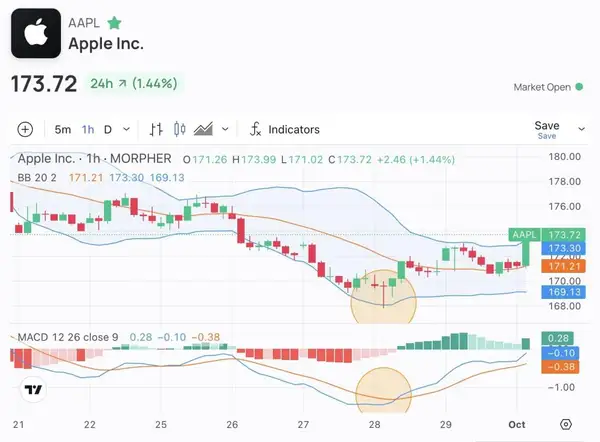
In this case, both indicators give you a potential entry opportunity (indicated by the orange circle on the chart). Firstly, the red candle gets out of the “Bollinger Bands”; secondly, the blue line crosses the orange line on the MACD.
So, by integrating both analyses, you ensure not only the intrinsic value of the stock but also an opportune moment to enter the market.
Obviously, this was just a quick example to give you an idea of the approach. In real life, it’s not that easy and fundamental and technical analysis have many more nuances and different parts to it. The key is to embrace both methods and build your own strategy accordingly.
How to Choose a Trading Style
Finally, every strategy has a certain trading style. If you are only looking to invest for the long term, that is already your strategy – buy and never sell.
However, if you are aiming for higher returns in the short term, many different trading styles might help you achieve that.
You can choose from the lightning-fast pace of day trading to the more relaxed swing trading approach. Just like you wouldn't wear slippers to go hiking, choosing a trading style that suits your personality and goals is crucial. So, if you're the type of person who gets bored easily, day trading might be a better fit for you. But swing trading might be the way to go if you're more patient and prefer a more hands-off approach.
Read our article “Swing Trading vs. Scalping: Which Is Better?” to help you decide which trading style suits you better. To get some inspiration on swing trading, you could also take a look at our curated list of the most successful swing traders of all time.
Putting Together a Winning Strategy
This may be a lot of information at once for someone who wants to learn stock market trading. For that reason, we want to summarise this part once again below so you can mix and match the different components when thinking of a winning strategy.
1. Define Your Goal:
Define your “Why”: Understand the underlying reason for your investment, be it for retirement, a dream vacation, buying a house, or simply wealth accumulation.
- Short-Term Goals (1-2 years): If aiming for high returns quickly, consider riskier assets like high-volatility stocks.
- Long-Term Goals (5-10+ years): Focus on value investing, capitalising on the historical upward trend of the market over extended periods.
2. Risk Assessment:
- Conservative (Preserve capital, low returns)
- Moderate (Balanced risk, medium returns)
- Aggressive (High risk, high potential returns)
3. Diversification Strategy:
- Broad Diversification (Ray Dalio Approach): Spread investments across different asset classes to achieve stable returns.
- Focused Investment (Charlie Munger Approach): Concentrate on areas you understand deeply to avoid “deworsification.”
4. Analysis Method:
- Technical Analysis: Study past stock price performances and forecast future movements based on historical data.
- Fundamental Analysis: Analyze a company's economic, financial, and other relevant factors to determine its intrinsic value.
5. Trading Style:
- Day Trading: Buy & sell within a single trading day. Suitable for those who can monitor markets closely.
- Swing Trading: Hold positions for several days to weeks. Requires less monitoring and offers the potential for significant gains.
- Long-Term Investing: Hold positions for years or even decades. Focus on steady growth and compounding returns. Less influenced by short-term market fluctuations.
How to Find a Trading Platform That You Can Trust
Criteria for Selecting a Platform
There are many platforms where you can invest in stocks. Similarly to choosing the right stocks to invest in, you should also choose the right platform, as it can be a game-changer for your success. Before committing, take your time to research and consider the following criteria to ensure a seamless and profitable trading experience:
Fees and Commissions: Think of fees like sneaky ants at a picnic. Small, but they can ruin your day. If you're making many trades, even tiny fees add up. So, look for low or zero fees.
User Interface: Ever get lost using a new app? A trading platform should be easy to use. You want to buy and sell, not play puzzle games.
Customer Support: When dealing with money, you want answers, and fast. A good platform will have real people ready to help when things get tricky.
Research and Educational Resources: Imagine a tool kit for trading. Good platforms offer guides and tips, especially for beginners. It's like a mini-school for trading.
Why Morpher Is the Best Trading Platform for Beginners
Morpher has become one of the most popular trading platforms, especially for newcomers. Do not take it from us but from hundreds of reviews from users. Morpher has an “Excellent” rating on Trustpilot, with people praising the platform's great user interface and responsive customer support.
We are a company that was created by Martin Froehler, a former professional hedge fund manager with years of experience in the cryptocurrency industry. He was eager to create the best possible experience a trader might have and that is how he finally describes Morpher:
“Trading on Morpher is better for the investor in every dimension compared to traditional exchanges.”
Morphers features often surpass other platforms by far. At Morpher, all markets are always tradable 24/7, with Zero Fees, Unique Markets, Infinite Liquidity, and much more.

The best part about it? You can sign up within 2 minutes; no KYC or verification is required at first – you can start trading the stock market immediately!
Make Your First Stock Market Trade In 3 Easy Steps
- Go to Morpher and Sign-Up (takes 2 mins); no KYC required

- Click on “Stocks” on the left side. You will see a lot of stocks that you are able to trade.
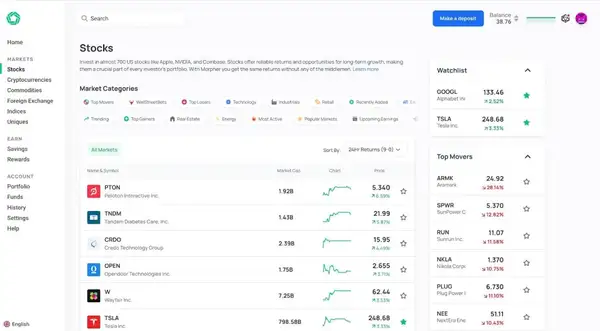
- Click on one of the Stocks and you get to the trading page. We like Tesla, so this will be our first trade. On the Tesla trading page, you can simply click on Buy or Sell on the right-hand side. Voila – You have done your first trade! Congratulations.

Conclusion
Before you start your trading journey, know that this article should serve you merely as a starting point. The ultimate objective is cultivating your trading theories and strategies through a cyclical trial, assessment, learning, and adjustment process. So go out there and create your own – because that is what trading is about! Just keep in mind to adhere to the basics of this article and assess risk correctly. Be smart about the risks you take, and do not be foolish about your investments:
“A 10% decline in the market is fairly common—it happens about once a year. Investors who realise this are less likely to sell in a panic, and more likely to remain invested, benefitting from the wealth-building power of stocks.” – Christopher Davis
Finally, we want to guide you towards further resources that could come in handy for you as you progress throughout your trading journey. Start by reading the best books on investments and best books on technical analysis. Go on and look for inspirational examples of the best traders before you. Finally, dig deeper into specific topics like Candlestick Patterns for spotting better entries or creating a Cryptocurrency Portfolio for potentially higher returns.

Disclaimer: All investments involve risk, and the past performance of a security, industry, sector, market, financial product, trading strategy, or individual’s trading does not guarantee future results or returns. Investors are fully responsible for any investment decisions they make. Such decisions should be based solely on an evaluation of their financial circumstances, investment objectives, risk tolerance, and liquidity needs. This post does not constitute investment advice.

Painless trading for everyone
Hundreds of markets all in one place - Apple, Bitcoin, Gold, Watches, NFTs, Sneakers and so much more.

Painless trading for everyone
Hundreds of markets all in one place - Apple, Bitcoin, Gold, Watches, NFTs, Sneakers and so much more.









